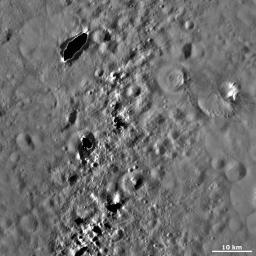This Dawn framing camera (FC) image of Vesta shows Fabia crater on the right side of the image. Fabia crater is roughly 12 kilometers (7.5 miles) in diameter and has a large area of bright material originating from its top right rim and slumping towards its center. The top left rim of Fabia is more degraded than the rest of the rim, which is likely due to debris slumping into the crater and covering up this part of the rim. There are many boulders located on the debris and around the top part of Fabia crater. These boulders are much less than 1 kilometer (0.6 mile) wide and are identified by the shadows that they cast to the left. Note that the large dark patches with bright rims in the left of the image are artifacts that result from the processing of the image and are not features on Vesta's surface.
This image is located in Vesta's Numisia quadrangle, in Vesta's northern hemisphere. NASA's Dawn spacecraft obtained this image with its framing camera on Oct. 24, 2011. This image was taken through the camera's clear filter. The distance to the surface of Vesta is 700 kilometers (435 miles) and the image has a resolution of about 62 meters (203 feet) per pixel. This image was acquired during the HAMO (high-altitude mapping orbit) phase of the mission.
The Dawn mission to Vesta and Ceres is managed by NASA's Jet Propulsion Laboratory, a division of the California Institute of Technology in Pasadena, for NASA's Science Mission Directorate, Washington D.C. UCLA is responsible for overall Dawn mission science. The Dawn framing cameras have been developed and built under the leadership of the Max Planck Institute for Solar System Research, Katlenburg-Lindau, Germany, with significant contributions by DLR German Aerospace Center, Institute of Planetary Research, Berlin, and in coordination with the Institute of Computer and Communication Network Engineering, Braunschweig. The Framing Camera project is funded by the Max Planck Society, DLR, and NASA/JPL.
More information about the Dawn mission is online at http://www.nasa.gov/dawn and http://dawn.jpl.nasa.gov.

 Planetary Data System
Planetary Data System












